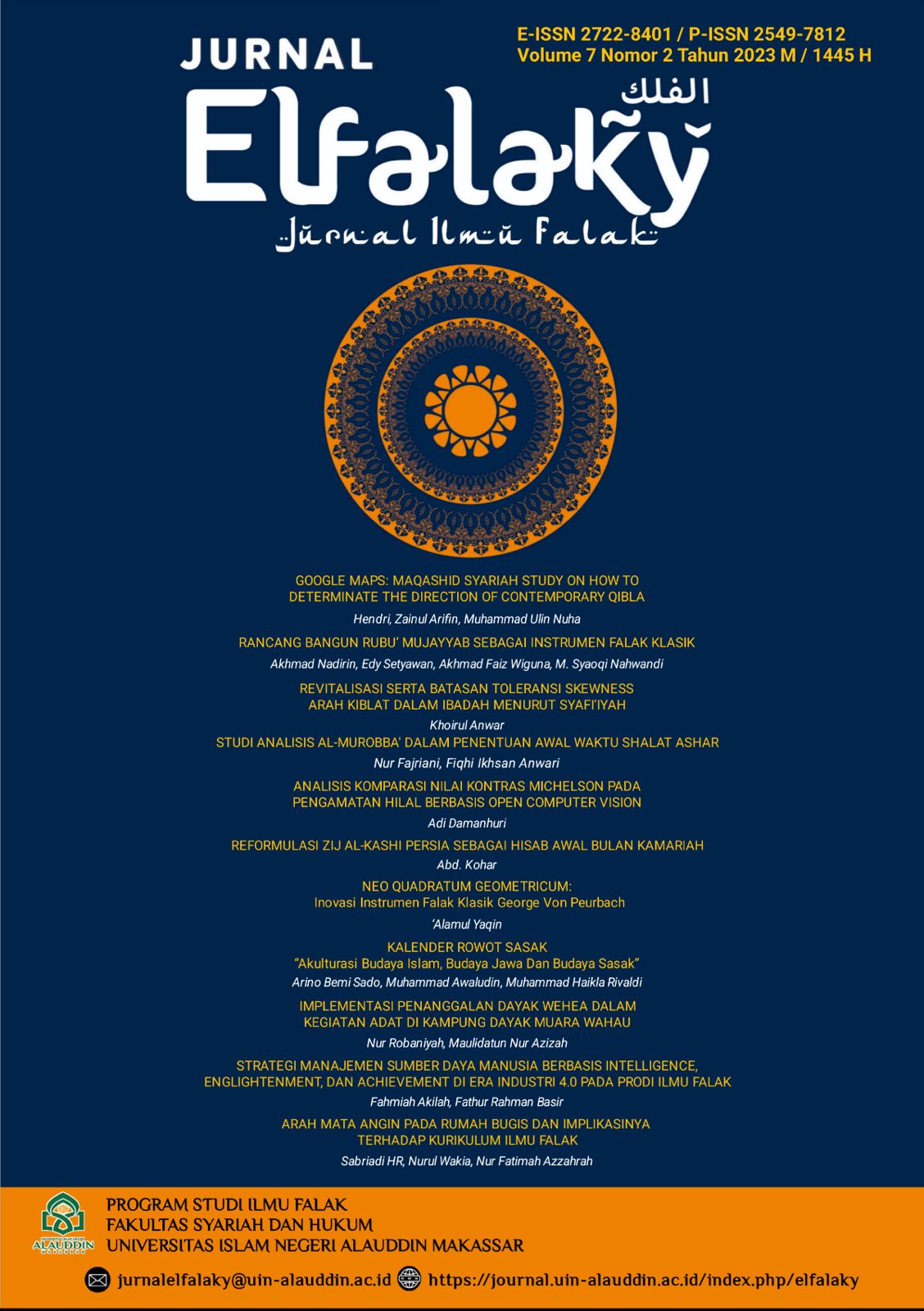NEO QUADRATUM GEOMETRICUM: Inovasi Instrumen Falak Klasik George Von Peurbach
Abstract
Quadratum Geometricum is a surveying and astronomical instrument by George Von Peurbach who is known as an Austrian astronomer. This article discusses the accuracy and development concept of Quadratum Geometricum which is named Neo Quadratum Geometricum. This research is development research, which has 2 stages, namely the preliminary stage and the formative evaluation stage which consists of: self evaluation, prototyping (expert reviews and one-to-one, and small groups), and field tests. The findings of this study include: Neo Quadratum Geometricum innovation, namely the existence of a conversion arc from the value of the horizontal and vertical rulers which serves to value of the angle of tan/cotan immediately known without looking at the table. Quadratum Geometricum is more accurate in the tan angle conversion test, Neo Quadratum Geometricum is 0.0025 greater than the calculator, while Quadratum Geometricum is the same. Because, the accuracy of Neo Quadratum Geometricum is only up to minutes. However, in terms of the effectiveness of using Neo Quadratum Geometricum it is more practical, because it does not use tables. In measuring the height of the object, the difference is 8.5 cm from the actual height.
References
Akker, Jan van den. “Principles and Methods of Development Research.” In Design Approaches and Tools in Education and Training, edited by Jan van den Akker, Robert Maribe Branch, Kent Gustafson, Nienke Nieveen, and Tjeerd Plomp, 1–14. Dordrecht: Springer Netherlands, 1999. https://doi.org/10.1007/978-94-011-4255-7_1.
Britannica. “Surveying.” Encyclopædia Britannica, Inc., 2023. https://www.britannica.com/technology/surveying/The-theodolite.
Ellis, Timothy J., and Yair Levy. “Towards a Guide for Novice Researchers on Research Methodology: Review and Proposed Methods.” Issues in Informing Science and Information Technology 6 (2009).
Evans, James. The History and Practice of Ancient Astronomy, 401. New York: Oxford Press, 1998.
Gessner, Samuel. Images and Text Featuring The Quadratum Geometricum in Lisbon 1580-1640 dalam acara SIC 2011 sesi IVa : The Long Arch of Mathematical Instrumens pada 21 September 2011.
Mozaffari, S. Mohammad dan Georg Zotti. The Observational Instrumens at the Maragha Observatory after AD 1300, Jurnal Suhayl Vol. 12 2013.
Pedersen, Olaf. "Early Physics and Astronomy: A Historical Introduction", 247. Victoria: Cambridge University Press, 1993
Rietz, H.L, J.F Reilly, dan Roscoe Woods. Plane and Spherical Trigonometry, 1-3. New York: The Macmilan Company, 1936.
Peurbach, George Von, Quadratum goemetricum. Nuremberg: per loannem Stuchs, 1516
Setiawan, Hasrian Rudi, Arwin Juli Rakhmadi, and Muhammad Hidayat. “Pemanfaatan Media Rubu’Al-Mujayyab Pada Pembelajaran Matematika Di Sekolah.” Idrak: Journal of Islamic Education 2, no. 2 (2020): 227. http://jurnal.stit-rh.ac.id/index.php/idrak/article/view/128.
Simonyi, Karoly. A Cultural History of Physics, 165, New york: CRC Press, 2012
Valleriani, Matteo. Mettalurgy Ballistic and Epistemic Instrumens: The Nova Scientia of Nicob Tartaglia, 25. Berlin: Creative Commons, 2013.
Zinner, E., E. Brown, Regimontanus : His Life and Work (Studies the History and Philosofy of Mathematics), 26. Amsterdam: Elsevier Science Publisher B.V, 1990.
http://www-history.mcs.st-andrews.ac.uk/Biographies/Peurbach.html diakses pada 5 Oktober 2017 pukul 1:04 WIB





